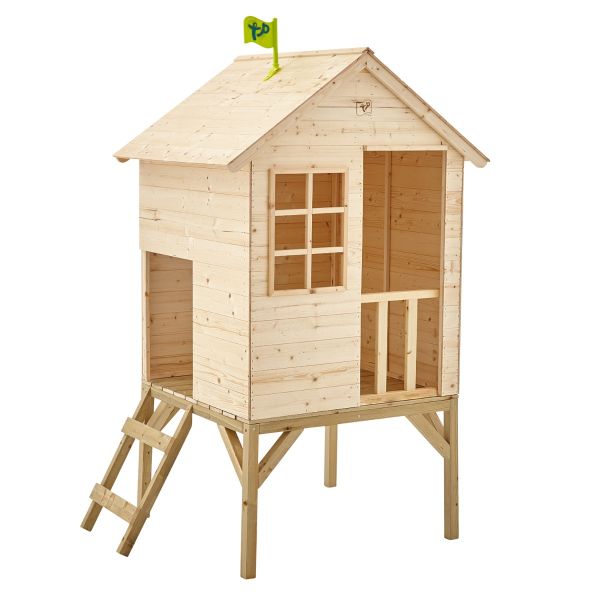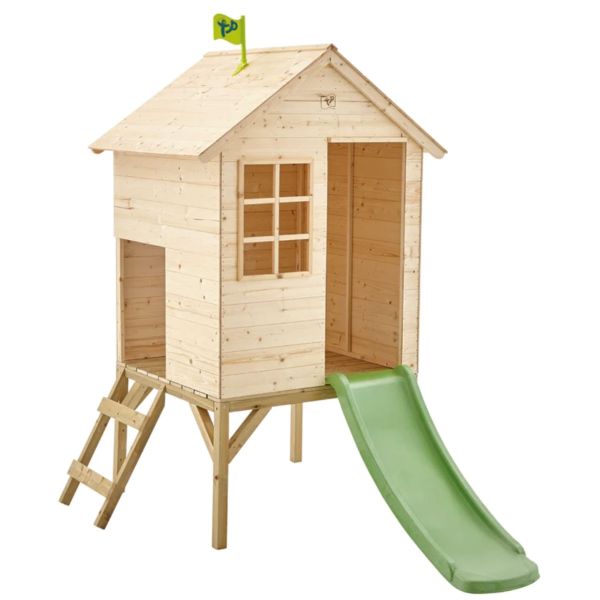• What are the benefits of a kids' playhouse for your child?
Playhouses are incredibly exciting for young children, especially if they come with additional features like climbing towers and slides. They can decorate the enclosed interior spaces whichever way they like, creating their own space for independent play. Their outdoor playhouse can become anything they want it to, whether that’s a secret hideout, an arts and craft space, or simply a playroom to spend time in with their favourite toys.
From teepees to Wendy houses and rockets to castles, the sky is the limit. Your child’s playhouse is more than just a hideaway or playground, it’s an important tool to help them develop motor skills and creativity. If you have multiple small children who can play together, the shared playhouse will encourage social skills and problem-solving in addition to boosting the possibilities of imaginative group play – resulting in happier and healthier kids.
It’s recommended for children under 5 years old to spend at least 180 minutes a day doing physical activities, and for children over 5 years old to get at least 60 minutes a day of physical activity. With exciting features like wave slides, scrambling nets, climbing walls, and firefighter poles, these outdoor playhouses offer countless ways for kids to get outdoors in the fresh air and meet the guidelines for healthy physical activity.
With the All Out Play playhouses we supply being suitable for children aged 3 years plus, younger children can truly get the most out of your investment in their childhood by enjoying the outdoor play equipment from toddlerhood into their early teenage years.
• Why choose a wooden outdoor playhouse?
Whether you’re opting for a classic wooden playhouse or something more unusual like a fort or climbing den, all of our kids' playhouses are made from sturdy durable materials for safety and weather resistance. They’re designed to stand the test of time, keeping your kids playing outdoors and getting valuable exercise instead of staring at screens for too long.
All wooden elements are made from either premium Redwood Pine or Douglas Fir timber, with roofs made from tough plywood and hardwood, ensuring that your outdoor playhouse stands firm for many years. The planed timber also undergoes a high-pressure treatment to help prevent fungal decay. Metal fixings are domed or countersunk for safety and made from stainless steel to resist rust and corrosion, too.
The wood can be left as it is to enjoy its natural grain, or you can use paint or wood stain in a colour of your choice to customise the appearance of your outdoor playhouse. It’s easy to ensure that the playhouse fits in with the aesthetic of your other garden furniture, especially if you have a particular theme you’d like to uphold throughout without compromising on your child’s recreation opportunities.
As long as you take good care of your child’s playhouse, they’ll be enjoying hours of wholesome entertainment and making formative memories for years to come. The fun never stops when you can change the décor along with their tastes as they grow, meaning a fairy-tale cottage can become a superhero’s headquarters or a pirate ship can turn into a princess castle with just a splash of paint.
• How to paint a wooden playhouse for kids?
Most of the wooden playhouses available from Wicken Toys are pre-treated, but not stained or painted – giving you the freedom to decorate your chosen structure however you like. You can leave it as it is, and let your child’s imagination do the work, or you can get creative and transform their garden playhouse into a stunning visual feature in your backyard.
Here are the steps you should follow to paint your wooden outdoor playhouse:
1) The first question is whether you want a more natural-looking wood stain or a smoother and brighter paint colour. Both offer a fantastic finish, but it’s up to you which aesthetic you prefer. Whichever route you go down, be sure to select a non-toxic paint or stain that’s durable enough to withstand the weather, but won’t expose anyone to harmful chemicals.
2) If you want to paint your child’s playhouse, you’ll need a water-based exterior paint and a matching undercoat. You can go for matt paint for a non-reflective finish, gloss paint for a shiny pop of colour, or satin or semi-gloss paint for an in-between sheen. Why not turn the job of choosing the colour and painting the playhouse into a fun family activity?
3) Before you start applying anything, clean every surface you intend to paint so they’re completely free of dirt and dust. Then, you should use fine sandpaper to smooth down the surfaces to prepare them for the paint. You may want to use painter’s tape for clean edges, and lay down newspaper if you’re painting inside to prevent drips from going everywhere.
4) Start by applying the undercoat and allowing it to dry before applying the primary paint colour. Let the first coat dry properly before applying a second coat. This should be enough to achieve the finish you’re looking for, but you may want to apply another coat if the colour isn’t strong enough.
5) If you’re painting trims, window frames, or doors in a different colour, do this last using a smaller brush. After everything is dry and any tape has been removed, cover everything with a coat of water-based sealant to protect it. Once this final coat has dried, you’ll be ready to add furnishings like rugs, bean bags, or even fairy lights!
Whenever you want to re-paint the wooden playhouse, you’ll need to sand it down again and re-treat it with sealant before applying a new paint colour.
• How to protect a wooden playhouse?
At Wicken Toys, we give our customers the guarantee that our products will last for the long term, ensuring that you’re always making a worthwhile investment when you buy from us. However, in cases of extreme weather exposure and excessive wear and tear, a wooden playhouse can lose the fresh appeal it once had. If you want to keep your outdoor playhouse in the best possible condition, then you’ll need to keep up with the maintenance of the wood and moving parts.
When you first set up the playhouse, you should make sure there are no gaps in the structure and everything is sufficiently sealed against water and other sources of damage. You should regularly check that bolts and hinges in doors and windows are working smoothly without rust, and that there’s no discolouration or weakening of the roof and walls.
Smaller plastic playhouses can be brought inside garages when not in use to prevent weathering, or you may want to cover larger structures with a tarpaulin during rainy weather. However, do not leave a kids playhouse covered for long periods of time, as this encourages moisture build-up, which then leads to rot and mould. If you find that the playhouse gets muddy or dusty, clean it with a soft bristle brush and warm soapy water, avoiding chemical cleaning solutions.
The best way to protect your outdoor playhouse against the elements and the general wear of countless playtimes is to treat it with a preservative stain at least once a year. You can use a transparent sealant or wood preserver if you want to maintain the appearance of natural wood or the brightness of coloured paint, or try a tinted wood stain if you’d like to change the colour of your wooden playhouse while keeping it healthy and strong.
These treatments prevent the wood from shrinking, expanding, or warping, and help to dispel rot and fungi. Keeping up with annual wooden playhouse treatments will extend the lifespan of the product, allowing the kids to enjoy it for even longer.
If you think you’ll need help installing the outdoor playhouse you intend to order, please contact Wicken Toys to discuss a quote for delivery and installation services for this product.
• Does a wooden playhouse need a base?
The base of your structure is crucial in ensuring that it is safe for use. If the base is unstable, then the wooden playhouse will be prone to falling over when weight is distributed unevenly. This is why we recommend that your outdoor playhouse is installed on flat land and never on a steep slope.
By laying the best possible foundations for your fun-filled product, you’ll give yourself the peace of mind that playing children will be safe at all times, and allow them to enjoy the intended thrills of a playhouse without the risk of injury.
Smaller playhouses may be constructed directly on level ground or grass; they should have been treated with a preservative wood stain to protect against damp and mould from the ground underneath. If you have a paved patio or wooden decking, this is perfect for placing a small kids playhouse.
Larger playhouses placed on less even ground are better off being constructed on top of a solid base, such as heavy-duty wood or concrete slabs. The surrounding area should have softer impact-absorbing ground such as grass, bark chips, or sand, especially for multi-storey tower playhouses.
You should always make sure that the playhouse is securely attached to the base, and that the location is appropriate before you commit to constructing a foundation and positioning the outdoor playhouse there. For the most stable and safe structure, ensure that the playhouse is in a dry area with a surrounding clear space of at least 1.8 metres.
This means no waterlogged ground, weeds, or overhanging foliage, wires, or washing lines should come within 2 metres of the outdoor playcentre. Don’t place it too close to fences or walls, and make sure it’s visible from the main house for easy supervision.
• Do you need planning permission for a wooden playhouse?
Depending on the height of your wooden playhouse, you might wonder whether you need planning permission to build it in your garden. The good news is, as a playhouse is a domestic structure that is used temporarily and not lived in, you usually needn’t worry about gaining approval. This means that you can go ahead and install a wooden outdoor playhouse without being concerned about applying for planning permission beforehand.
That said, larger structures might require permission from your local council. Though you might think permission isn’t required to put a playhouse on your own property, tall structures can infringe on neighbours’ privacy or obstruct views. The majority of kids playhouses won’t need planning permission, but two-storey playhouses and ones with taller roofs might.
Outdoor playhouses are likely to need planning permission if they're:
- Covering half the garden (with a floor area exceeding 30m²)
- More than 3m tall with a pent roof
- Over 4m high with an apex roof
- On a platform more than 30cm high
- Within 2m of a boundary and over 2.5m tall
- Within 1m of a boundary with a floor area exceeding 20m²
- Situated between the dwelling and a public highway
Public highways include roads and footpaths, and generally, you shouldn’t put a playhouse in front of your property. Before ordering an outdoor playhouse, we recommend checking the measurements of the playhouse and your garden, then contacting your local authority to check the regulations for outbuildings and find out whether you’ll need permission from them to place it in your chosen position.
Please note that Wicken Toys cannot be held responsible for planning permission issues with outdoor playhouses ordered from us without the buyer checking local authority regulations first.


